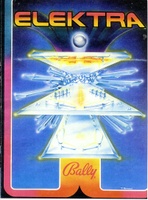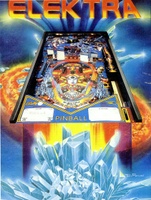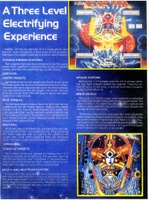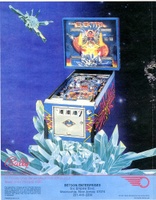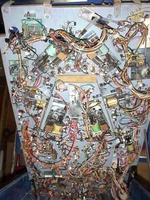

Elektra
First solid-state game with a three-level playfield. An earlier game with three levels is Chicago Vending Company's 1934 'Three Point'. The common version of backglass matches what is shown on the flyer, including the style of the "Elektra Girl". An earlier version backglass is shown in this listing and more closely resembles the original backglass painting with the original Elektra Girl. We have designated this backglass as Early Production. The quantity produced of these early glasses is unknown to us. Collector Bill Kurtz stated in an online auction: After this painting was completed, Bally executives felt that the expression on the girl's face was too stern and they weren't happy that the outlines of her nipples were visible in the artwork. So the Elektra Girl was redrawn and superimposed in the center of this painting, creating the more familiar ELEKTRA backglass for the production games. Bally produced a very small number of backglasses from this painting, however, before the Elektra Girl was redrawn. Included in this listing is the original artwork for the original Elektra Girl. Also included here are pictures of a game located in the USA that has a dual coin door to accommodate a bill validator. The photographer found no serial number stamped anywhere on the outside cabinet, including in the usual and expected place, but did not look at the circuits boards for serial number stickers there. Under the playfield was a stapled tag with a serial number that might read 000344. For more information on these dual coin doors, see Bally's 1982 'Vector'. Collector Christian Jacobs in Germany contacted us in 2014 stating he noticed on a few Vector cabinets that they appeared to be Elektra cabinet artwork overpainted with the Vector artwork. He recalled one such Vector game had serial number EVE 2405. We note that Vector was the next game produced after Elektra. Claude Fernandez (designer of Elektra) told us that if Bally had any leftover cabinets from the Elektra production they would have repainted them to be used for Vector instead of throwing them out. Greg Kmiec (designer of Vector) told us that perhaps Bally cut the production run of Elektra in order to push Vector into the market.
